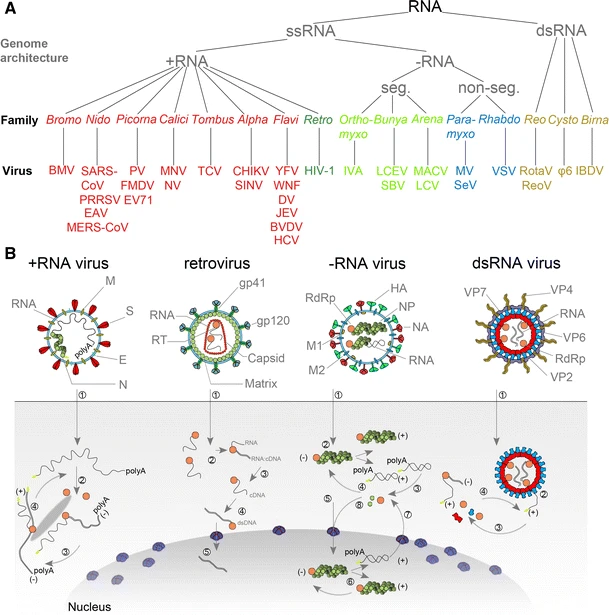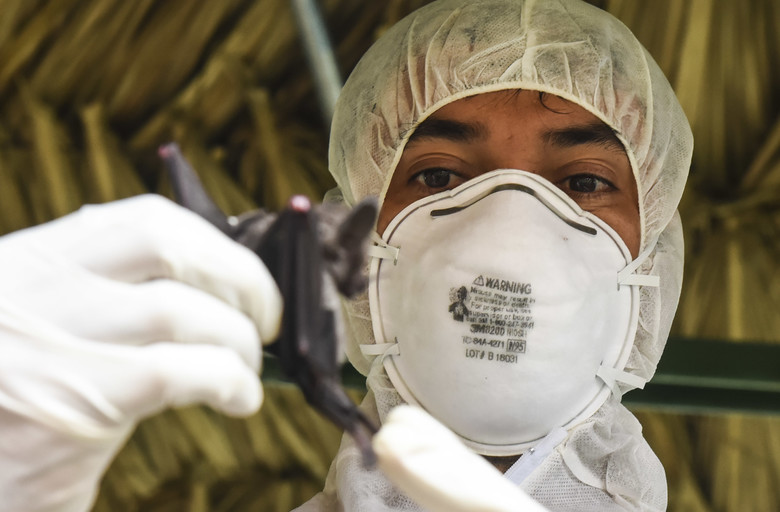|
Magboi Virus
Magboi virus (MGBV) is a novel, bat-borne Orthohantavirus discovered in a slit-faced bat trapped near the Magboi Stream in eastern Sierra Leone in 2011. It is a single-stranded, negative sense, RNA virus in the Bunyavirales order. Molecular virology The discovery represented the first time a hantavirus was detected in a bat, although bats as a reservoir for hantavirus had been long suspected. On the basis of a maximum-likelihood phylogenetic tree, the sequence isolated from the Magboi River bat does not cluster with rodent-associated hantaviruses but groups with those found in shrews and moles. This raises the question of the real hantavirus host range. Bats are already known to harbor a broad variety of emerging pathogens, including other bunyaviruses. Their ability to fly and social life history enable efficient pathogen maintenance, evolution, and spread.Murphy WJ, Eizirik E, Johnson WE, Zhang YP, Ryder OA, O’Brien SJ Molecular phylogenetics and the origins of placental ... [...More Info...] [...Related Items...] OR: [Wikipedia] [Google] [Baidu] |
Bunyavirales
''Bunyavirales'' is an order of segmented negative-strand RNA viruses with mainly tripartite genomes. Member viruses infect arthropods, plants, protozoans, and vertebrates. It is the only order in the class ''Ellioviricetes''. The name ''Bunyavirales'' derives from Bunyamwera, where the original type species ''Bunyamwera orthobunyavirus'' was first discovered. ''Ellioviricetes'' is named in honor of late virologist Richard M. Elliott for his early work on bunyaviruses. Bunyaviruses belong to the fifth group of the Baltimore classification system, which includes viruses with a negative-sense, single-stranded RNA genome. They have an enveloped, spherical virion. Though generally found in arthropods or rodents, certain viruses in this order occasionally infect humans. Some of them also infect plants. In addition, there is a group of bunyaviruses whose replication is restricted to arthropods and is known as insect-specific bunyaviruses. A majority of bunyaviruses are vector-borne ... [...More Info...] [...Related Items...] OR: [Wikipedia] [Google] [Baidu] |
Hantaviridae
''Hantaviridae'' is a family of viruses in the order ''Bunyavirales''. It is named for the Hantan River area in South Korea where an early outbreak of one of its species was observed. Taxonomy * '' Actantavirinae'' ** '' Actinovirus'' * '' Agantavirinae'' ** '' Agnathovirus'' * '' Mammantavirinae'' ** '' Loanvirus'' ** '' Mobatvirus'' ** ''Orthohantavirus ''Orthohantavirus'' is a genus of single-stranded, enveloped, negative-sense RNA viruses in the family '' Hantaviridae'' within the order ''Bunyavirales''. Members of this genus may be called orthohantaviruses or simply hantaviruses. Orthohantav ...'' ** '' Thottimvirus'' * '' Repantavirinae'' ** '' Reptillovirus'' References {{Taxonbar, from=Q29001075 Virus families Bunyavirales ... [...More Info...] [...Related Items...] OR: [Wikipedia] [Google] [Baidu] |
Orthohantavirus
''Orthohantavirus'' is a genus of single-stranded, enveloped, negative-sense RNA viruses in the family ''Hantaviridae'' within the order ''Bunyavirales''. Members of this genus may be called orthohantaviruses or simply hantaviruses. Orthohantaviruses typically cause chronic asymptomatic infection in rodents. Humans may become infected with hantaviruses through contact with rodent urine, saliva, or feces. Some strains cause potentially fatal diseases in humans, such as hantavirus hemorrhagic fever with renal syndrome (HFRS), or hantavirus pulmonary syndrome (HPS), also known as hantavirus cardiopulmonary syndrome (HCPS), while others have not been associated with known human disease (e.g. Prospect Hill virus). HPS (HCPS) is a "rare respiratory illness associated with the inhalation of aerosolized rodent excreta (urine and feces) contaminated by hantavirus particles." Human infections of hantaviruses have almost entirely been linked to human contact with rodent excrement; however, ... [...More Info...] [...Related Items...] OR: [Wikipedia] [Google] [Baidu] |
Sierra Leone
Sierra Leone,)]. officially the Republic of Sierra Leone, is a country on the southwest coast of West Africa. It is bordered by Liberia to the southeast and Guinea surrounds the northern half of the nation. Covering a total area of , Sierra Leone has a tropical climate, with diverse environments ranging from savanna to rainforests. The country has a population of 7,092,113 as of the 2015 census. The capital and largest city is Freetown. The country is divided into five administrative regions, which are subdivided into Districts of Sierra Leone, 16 districts. Sierra Leone is a constitutional republic with a unicameral parliament and a directly elected executive president, president serving a five-year term with a maximum of two terms. The current president is Julius Maada Bio. Sierra Leone is a Secular state, secular nation with Constitution of Sierra Leone, the constitution providing for the separation of state and religion and freedom of conscience (which includes freedom of ... [...More Info...] [...Related Items...] OR: [Wikipedia] [Google] [Baidu] |
Negative Sense
In molecular biology and genetics, the sense of a nucleic acid molecule, particularly of a strand of DNA or RNA, refers to the nature of the roles of the strand and its complement in specifying a sequence of amino acids. Depending on the context, sense may have slightly different meanings. For example, negative-sense strand of DNA is equivalent to the template strand, whereas the positive-sense strand is the non-template strand whose nucleotide sequence is equivalent to the sequence of the mRNA transcript. DNA sense Because of the complementary nature of base-pairing between nucleic acid polymers, a double-stranded DNA molecule will be composed of two strands with sequences that are reverse complements of each other. To help molecular biologists specifically identify each strand individually, the two strands are usually differentiated as the "sense" strand and the "antisense" strand. An individual strand of DNA is referred to as positive-sense (also positive (+) or simply sense) i ... [...More Info...] [...Related Items...] OR: [Wikipedia] [Google] [Baidu] |
RNA Virus
An RNA virus is a virusother than a retrovirusthat has ribonucleic acid (RNA) as its genetic material. The nucleic acid is usually single-stranded RNA ( ssRNA) but it may be double-stranded (dsRNA). Notable human diseases caused by RNA viruses include the common cold, influenza, SARS, MERS, Covid-19, Dengue Virus, hepatitis C, hepatitis E, West Nile fever, Ebola virus disease, rabies, polio, mumps, and measles. The International Committee on Taxonomy of Viruses (ICTV) classifies RNA viruses as those that belong to ''Group III'', ''Group IV'' or ''Group V'' of the Baltimore classification system. This category excludes ''Group VI'', viruses with RNA genetic material but which use DNA intermediates in their life cycle: these are called retroviruses, including HIV-1 and HIV-2 which cause AIDS. As of May 2020, all known RNA viruses encoding an RNA-directed RNA polymerase are believed to form a monophyletic group, known as the realm '' Riboviria''. The majority of such RNA ... [...More Info...] [...Related Items...] OR: [Wikipedia] [Google] [Baidu] |
Charles Calisher
Charles Calisher is professor emeritus of microbiology at the College of Veterinary Medicine & Biomedical Sciences at Colorado State University. Education and career Calisher received a bachelor's degree in bacteriology from the Philadelphia College of Pharmacy and Science, a master's degree in biology and gnotobiosis from the University of Notre Dame, and a Ph.D. in Microbiology from Georgetown University. His research interests include ecology and epidemiology, viral diagnostics, viral taxonomy, viral evolution of roboviruses, arboviruses, and hantaviruses ''Orthohantavirus'' is a genus of single-stranded, enveloped, negative-sense RNA viruses in the family '' Hantaviridae'' within the order ''Bunyavirales''. Members of this genus may be called orthohantaviruses or simply hantaviruses. Orthohantav .... References American microbiologists Colorado State University faculty Living people University of the Sciences alumni Notre Dame College of Arts and Letters al ... [...More Info...] [...Related Items...] OR: [Wikipedia] [Google] [Baidu] |
Phylogenetic Tree
A phylogenetic tree (also phylogeny or evolutionary tree Felsenstein J. (2004). ''Inferring Phylogenies'' Sinauer Associates: Sunderland, MA.) is a branching diagram or a tree showing the evolutionary relationships among various biological species or other entities based upon similarities and differences in their physical or genetic characteristics. All life on Earth is part of a single phylogenetic tree, indicating common ancestry. In a ''rooted'' phylogenetic tree, each node with descendants represents the inferred most recent common ancestor of those descendants, and the edge lengths in some trees may be interpreted as time estimates. Each node is called a taxonomic unit. Internal nodes are generally called hypothetical taxonomic units, as they cannot be directly observed. Trees are useful in fields of biology such as bioinformatics, systematics, and phylogenetics. ''Unrooted'' trees illustrate only the relatedness of the leaf nodes and do not require the ancestral root to b ... [...More Info...] [...Related Items...] OR: [Wikipedia] [Google] [Baidu] |
Sangassou Virus
''Sangassou orthohantavirus'' (SANGV) is single-stranded, negative-sense RNA virus species of the genus ''Orthohantavirus'' in the ''Bunyavirales'' order. It was first isolated in an African wood mouse ('' Hylomyscus simus'') in the forest in Guinea, West Africa in 2010. It is named for the village near where the mouse was trapped. It is the first indigenous Murinae-associated African hantavirus to be discovered. Genome The virus genome consists of three segments of negative-stranded RNA; the large (L) segment encodes the viral RNA-dependent RNA polymerase, the medium (M) segment encodes the envelope glycoproteins Gn and Gc (cotranslationally cleaved from a glycoprotein precursor), and the small (S) segment encodes the nucleocapsid (N) protein. Renal syndrome In rodents, hantavirus produces a chronic infection with no adverse sequelae. In humans, hantavirus produces two major clinical syndromes: hemorrhagic fever or pulmonary syndrome. European, Asian, and African rodent-b ... [...More Info...] [...Related Items...] OR: [Wikipedia] [Google] [Baidu] |
Bat-borne Virus
The bat virome is the group of viruses associated with bats. Bats host a diverse array of viruses, including all seven types described by the Baltimore classification system: (I) double-stranded DNA viruses; (II) single-stranded DNA viruses; (III) double-stranded RNA viruses; (IV) positive-sense single-stranded RNA viruses; (V) negative-sense single-stranded RNA viruses; (VI) positive-sense single-stranded RNA viruses that replicate through a DNA intermediate; and (VII) double-stranded DNA viruses that replicate through a single-stranded RNA intermediate. The greatest share of bat-associated viruses identified as of 2020 are of type IV, in the family ''Coronaviridae''. Bats harbor several viruses that are zoonotic, or capable of infecting humans, and some bat-borne viruses are considered important emerging viruses. These zoonotic viruses include the rabies virus, SARS-CoV, MERS-CoV, Marburg virus, Nipah virus, and Hendra virus. While research clearly indicates that S ... [...More Info...] [...Related Items...] OR: [Wikipedia] [Google] [Baidu] |
Viral Diseases
Viral means "relating to viruses" (small infectious agents). Viral may also refer to: Viral behavior, or virality Memetic behavior likened that of a virus, for example: * Viral marketing, the use of existing social networks to spread a marketing message * Viral phenomenon, relating to contagion theory or the "virality" of network culture, such as a meme * Viral video, a video that quickly attains a high popularity Titled works * ''Viral'' (2016 American film), a 2016 American science fiction horror drama * ''Viral'' (2016 Hindi film), an Indian Bollywood film based on social media * ''Viral'' (web series), a 2014 Brazilian comedy web series * '' V/H/S: Viral'', an American anthology horror film * '' Viral: The Search for the Origin of COVID-19'', a book by Alina Chand and Matt Ridley See also * ''Virals'', a novel series by Kathy Reichs * Virulence Virulence is a pathogen's or microorganism's ability to cause damage to a host. In most, especially in animal system ... [...More Info...] [...Related Items...] OR: [Wikipedia] [Google] [Baidu] |



